Which Characteristic Is Not One Of The Main Features Used To Classify Animals?
Introduction to Animal Diversity
138 Features Used to Classify Animals
Learning Objectives
Past the cease of this section, you volition be able to practise the post-obit:
- Explain the differences in animal torso plans that support basic beast classification
- Compare and contrast the embryonic development of protostomes and deuterostomes
<!–<anchor id="ch27_module_2″/>–>Scientists have adult a classification scheme that categorizes all members of the beast kingdom, although at that place are exceptions to most "rules" governing creature nomenclature ((Figure)). Animals have been traditionally classified according to 2 characteristics: trunk plan and developmental pathway. The major feature of the body plan is its symmetry: how the body parts are distributed along the major body centrality. Symmetrical animals can exist divided into roughly equivalent halves along at to the lowest degree one axis. Developmental characteristics include the number of germ tissue layers formed during development, the origin of the mouth and anus, the presence or absenteeism of an internal body cavity, and other features of embryological development, such equally larval types or whether or not periods of growth are interspersed with molting.
Visual Connectedness
Animal phylogeny. The phylogenetic tree of animals is based on morphological, fossil, and genetic evidence. The Ctenophora and Porifera are both considered to be basal because of the absence of Hox genes in this group, but how they are related to the "Parahoxozoa" (Placozoa + Eumetazoa) or to each other, continues to be a matter of debate.

Which of the following statements is false?
- Eumetazoans have specialized tissues and parazoans don't.
- Lophotrochozoa and Ecdysozoa are both Bilataria.
- Acoela and Cnidaria both possess radial symmetry.
- Arthropods are more closely related to nematodes than they are to annelids.
<!–<para>C–>
Brute Characterization Based on Body Symmetry
At a very basic level of classification, truthful animals tin exist largely divided into three groups based on the type of symmetry of their body program: radially symmetrical, bilaterally symmetrical, and asymmetrical. Asymmetry is seen in 2 modern clades, the Parazoa ((Figure)a) and Placozoa. (Although we should note that the ancestral fossils of the Parazoa apparently exhibited bilateral symmetry.) One clade, the Cnidaria ((Figure)b,c), exhibits radial or biradial symmetry: Ctenophores have rotational symmetry ((Figure)due east). Bilateral symmetry is seen in the largest of the clades, the Bilateria ((Figure)d); however the Echinodermata are bilateral equally larvae and metamorphose secondarily into radial adults. All types of symmetry are well suited to meet the unique demands of a particular beast'southward lifestyle.
Radial symmetry is the arrangement of body parts around a central axis, as is seen in a bicycle wheel or pie. Information technology results in animals having top and lesser surfaces just no left and correct sides, nor front or back. If a radially symmetrical animal is divided in any management along the oral/aboral axis (the side with a mouth is "oral side," and the side without a mouth is the "aboral side"), the ii halves will be mirror images. This form of symmetry marks the trunk plans of many animals in the phyla Cnidaria, including jellyfish and adult body of water anemones ((Figure)b, c). Radial symmetry equips these ocean creatures (which may exist sedentary or only capable of slow motility or floating) to experience the environment equally from all directions. Bilaterally symmetrical animals, like butterflies ((Figure)d) have merely a unmarried plane forth which the body can be divided into equivalent halves. The Ctenophora ((Effigy)e), although they expect like to jellyfish, are considered to take rotational symmetry rather than radial or biradial symmetry because segmentation of the torso into two halves along the oral/aboral axis divides them into ii copies of the aforementioned half, with one re-create rotated 180o, rather than two mirror images.
Symmetry in animals. The (a) sponge is asymmetrical. The (b) jellyfish and (c) anemone are radially symmetrical, the (d) butterfly is bilaterally symmetrical. Rotational symmetry (e) is seen in the ctenophore Beroe, shown swimming open-mouthed. (credit a: modification of piece of work by Andrew Turner; credit b: modification of piece of work by Robert Freiburger; credit c: modification of work past Samuel Chow; credit d: modification of piece of work by Cory Zanker; credit e: modification of work by NOAA)
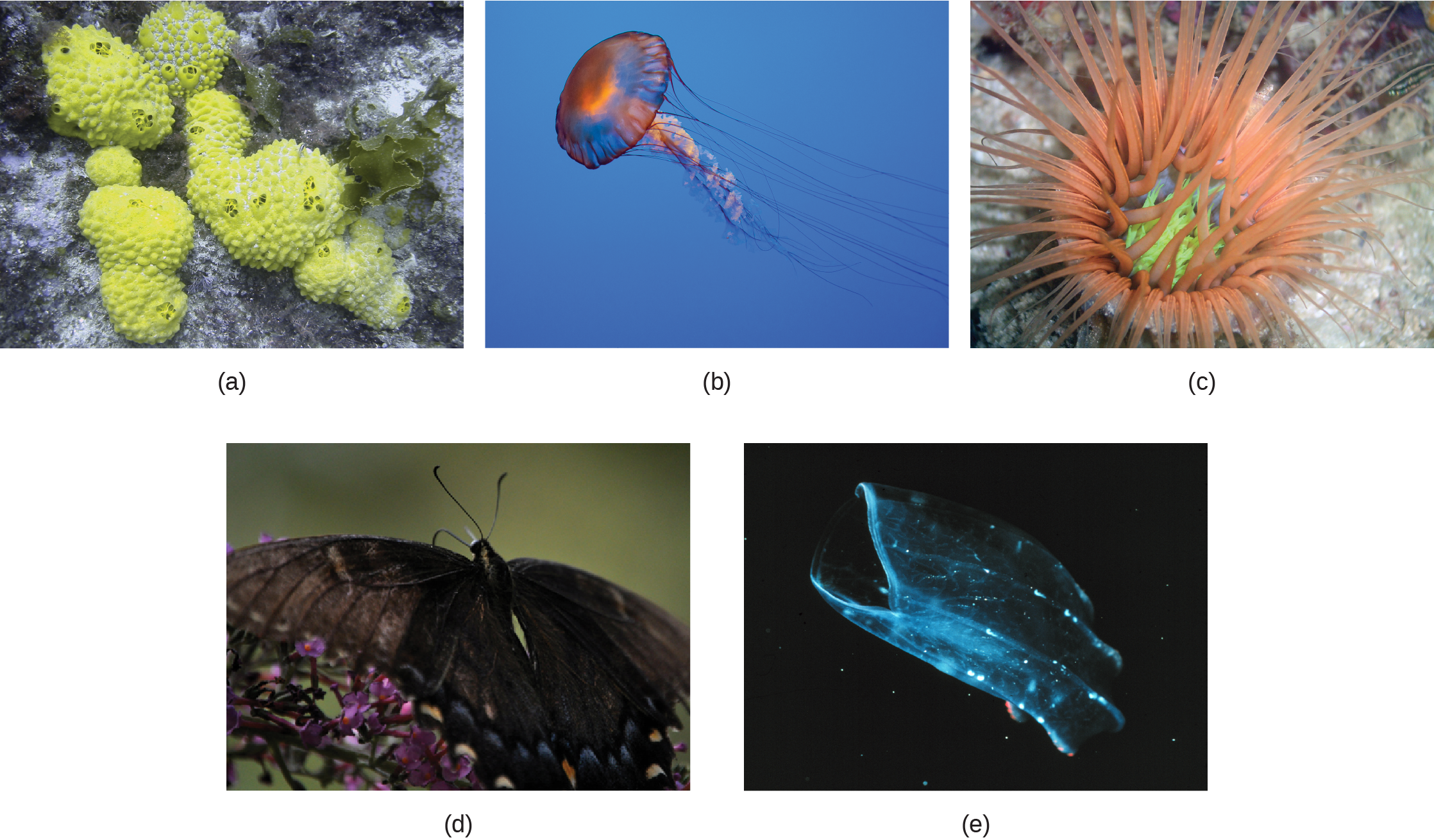
Bilateral symmetry involves the partitioning of the creature through a midsagittal plane, resulting in two superficially mirror images, right and left halves, such as those of a butterfly ((Figure)d), crab, or human body. Animals with bilateral symmetry have a "caput" and "tail" (inductive vs. posterior), front and back (dorsal vs. ventral), and right and left sides ((Figure)). All Eumetazoa except those with secondary radial symmetry are bilaterally symmetrical. The development of bilateral symmetry that allowed for the formation of anterior and posterior (head and tail) ends promoted a miracle chosen cephalization, which refers to the drove of an organized nervous organisation at the animal'southward inductive end. In contrast to radial symmetry, which is best suited for stationary or express-movement lifestyles, bilateral symmetry allows for streamlined and directional motion. In evolutionary terms, this unproblematic form of symmetry promoted active and controlled directional mobility and increased sophistication of resource-seeking and predator-prey relationships.
Bilateral symmetry. The bilaterally symmetrical human torso tin exist divided by several planes.
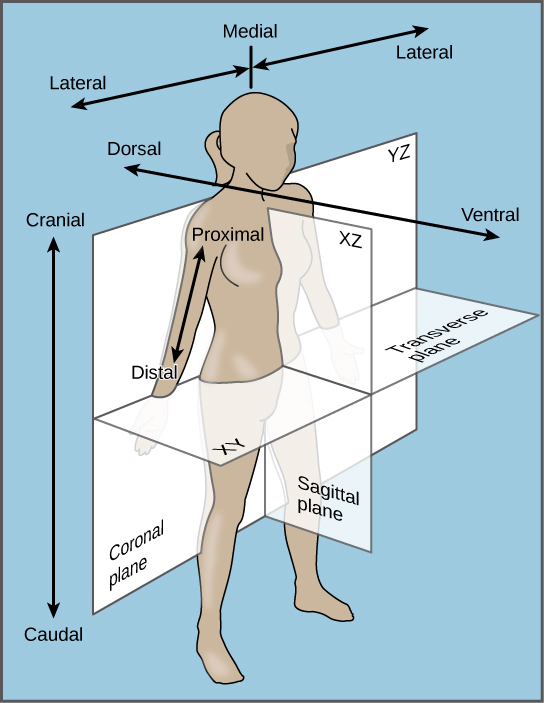
Animals in the phylum Echinodermata (such every bit sea stars, sand dollars, and sea urchins) display modified radial symmetry every bit adults, but as we have noted, their larval stages (such as the bipinnaria) initially exhibit bilateral symmetry until they metamorphose in animals with radial symmetry (this is termed secondary radial symmetry). Echinoderms evolved from bilaterally symmetrical animals; thus, they are classified as bilaterally symmetrical.
Link to Learning
Watch this video to meet a quick sketch of the different types of torso symmetry.
Fauna Characterization Based on Features of Embryological Development
Most fauna species undergo a separation of tissues into germ layers during embryonic development. Retrieve that these germ layers are formed during gastrulation, and that each germ layer typically gives rise to specific types of embryonic tissues and organs. Animals develop either two or three embryonic germ layers ((Effigy)). The animals that brandish radial, biradial, or rotational symmetry develop two germ layers, an inner layer (endoderm or mesendoderm) and an outer layer (ectoderm). These animals are called diploblasts, and take a nonliving eye layer between the endoderm and ectoderm (although private cells may be distributed through this heart layer, there is no coherent third layer of tissue). The iv clades considered to be diploblastic have different levels of complication and different developmental pathways, although there is picayune information near development in Placozoa. More circuitous animals (normally those with bilateral symmetry) develop three tissue layers: an inner layer (endoderm), an outer layer (ectoderm), and a middle layer (mesoderm). Animals with 3 tissue layers are called triploblasts.
Visual Connection
Diploblastic and triploblastic embryos. During embryogenesis, diploblasts develop 2 embryonic germ layers: an ectoderm and an endoderm or mesendoderm. Triploblasts develop a third layer—the mesoderm—which arises from mesendoderm and resides between the endoderm and ectoderm.
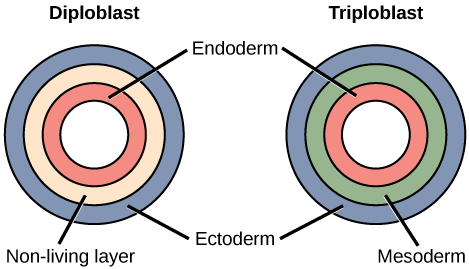
Which of the following statements near diploblasts and triploblasts is imitation?
- Animals that display just radial symmetry during their lifespans are diploblasts.
- Animals that brandish bilateral symmetry are triploblasts.
- The endoderm gives rise to the lining of the digestive tract and the respiratory tract.
- The mesoderm gives rise to the cardinal nervous system.
<!–<para> D–>
Each of the three germ layers is programmed to give rise to specific body tissues and organs, although there are variations on these themes. Generally speaking, the endoderm gives rise to the lining of the digestive tract (including the tum, intestines, liver, and pancreas), every bit well equally to the lining of the trachea, bronchi, and lungs of the respiratory tract, along with a few other structures. The ectoderm develops into the outer epithelial roofing of the torso surface, the central nervous organization, and a few other structures. The mesoderm is the tertiary germ layer; information technology forms betwixt the endoderm and ectoderm in triploblasts. This germ layer gives rise to all specialized muscle tissues (including the cardiac tissues and muscles of the intestines), connective tissues such as the skeleton and blood cells, and most other visceral organs such as the kidneys and the spleen. Diploblastic animals may take cell types that serve multiple functions, such as epitheliomuscular cells, which serve as a covering every bit well as contractile cells.
Presence or Absence of a Coelom
Further subdivision of animals with three germ layers (triploblasts) results in the separation of animals that may develop an internal body cavity derived from mesoderm, called a coelom, and those that do non. This epithelial prison cell-lined coelomic cavity, usually filled with fluid, lies between the visceral organs and the body wall. Information technology houses many organs such as the digestive, urinary, and reproductive systems, the heart and lungs, and likewise contains the major arteries and veins of the circulatory system. In mammals, the torso cavity is divided into the thoracic cavity, which houses the center and lungs, and the abdominal cavity, which houses the digestive organs. In the thoracic cavity further subdivision produces the pleural cavity, which provides space for the lungs to expand during animate, and the pericardial cavity, which provides room for movements of the eye. The evolution of the coelom is associated with many functional advantages. For case, the coelom provides cushioning and shock absorption for the major organ systems that it encloses. In addition, organs housed inside the coelom can grow and move freely, which promotes optimal organ development and placement. The coelom also provides infinite for the improvidence of gases and nutrients, as well as trunk flexibility, promoting improved fauna move.
Triploblasts that exercise not develop a coelom are called acoelomates, and their mesoderm region is completely filled with tissue, although they do still take a gut cavity. Examples of acoelomates include animals in the phylum Platyhelminthes, also known equally flatworms. Animals with a true coelom are called eucoelomates (or coelomates) ((Effigy)). In such cases, a true coelom arises entirely within the mesoderm germ layer and is lined past an epithelial membrane. This membrane too lines the organs within the coelom, connecting and belongings them in position while allowing them some freedom of movement. Annelids, mollusks, arthropods, echinoderms, and chordates are all eucoelomates. A third group of triploblasts has a slightly different coelom lined partly by mesoderm and partly past endoderm. Although however functionally a coelom, these are considered "simulated" coeloms, and then we call these animals pseudocoelomates. The phylum Nematoda (roundworms) is an instance of a pseudocoelomate. True coelomates can be further characterized based on other features of their early on embryological development.
Body cavities. Triploblasts may be (a) acoelomates, (b) eucoelomates, or (c) pseudocoelomates. Acoelomates have no body cavity. Eucoelomates have a trunk cavity within the mesoderm, called a coelom, in which both the gut and the trunk wall are lined with mesoderm. Pseudocoelomates also have a torso cavity, but only the torso wall is lined with mesoderm. (credit a: modification of work by Jan Derk; credit b: modification of work by NOAA; credit c: modification of work by USDA, ARS)
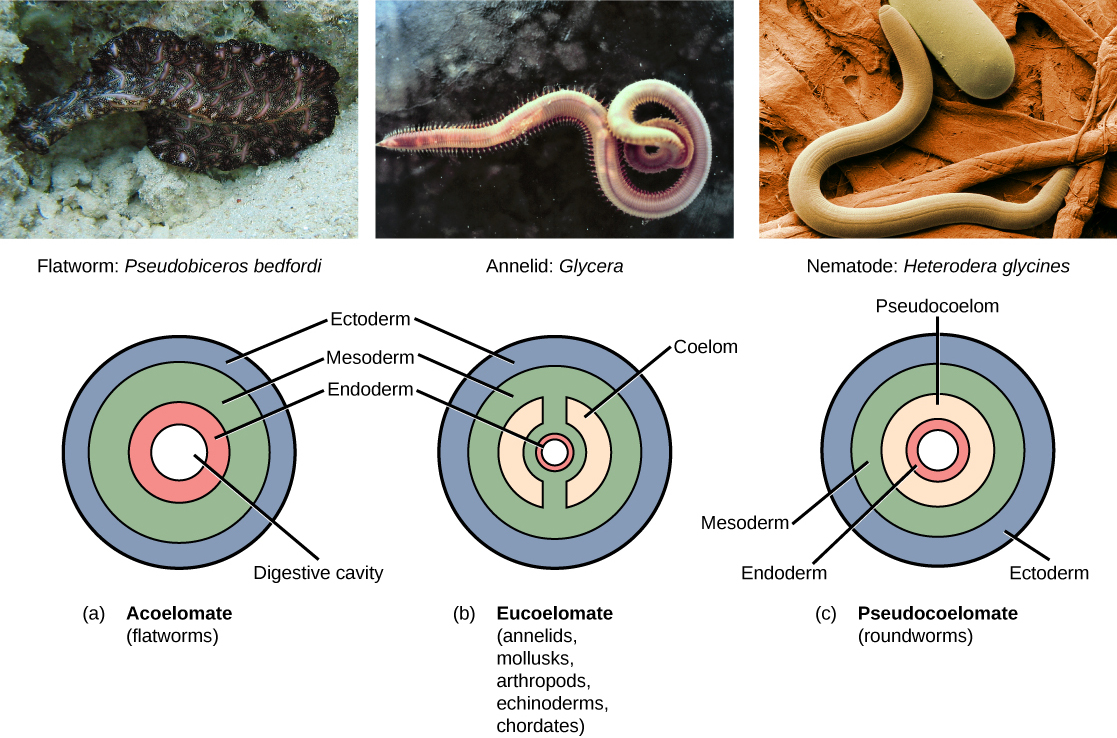
Embryonic Evolution of the Mouth
Bilaterally symmetrical, tribloblastic eucoelomates tin exist farther divided into 2 groups based on differences in the origin of the mouth. When the archaic gut forms, the opening that first connects the gut crenel to the outside of the embryo is called the blastopore. Most animals take openings at both ends of the gut: mouth at 1 terminate and anus at the other. One of these openings will develop at or near the site of the blastopore. In Protostomes ("rima oris first"), the mouth develops at the blastopore ((Figure)). In Deuterostomes ("mouth second"), the mouth develops at the other end of the gut ((Figure)) and the anus develops at the site of the blastopore. Protostomes include arthropods, mollusks, and annelids. Deuterostomes include more complex animals such as chordates just also some "unproblematic" animals such equally echinoderms. Recent evidence has challenged this simple view of the human relationship between the location of the blastopore and the formation of the oral fissure, withal, and the theory remains under debate. Nonetheless, these details of rima oris and anus formation reflect general differences in the organization of protostome and deuterostome embryos, which are also expressed in other developmental features.
One of these differences between protostomes and deuterostomes is the method of coelom formation, beginning from the gastrula stage. Since torso cavity formation tends to back-trail the germination of the mesoderm, the mesoderm of protostomes and deuterostomes forms differently. The coelom of most protostomes is formed through a process called schizocoely. The mesoderm in these organisms is ordinarily the production of specific blastomeres, which drift into the interior of the embryo and form 2 clumps of mesodermal tissue. Inside each clump, cavities develop and merge to form the hollow opening of the coelom. Deuterostomes differ in that their coelom forms through a process called enterocoely. Here, the mesoderm develops every bit pouches that are pinched off from the endoderm tissue. These pouches eventually fuse and aggrandize to fill the space between the gut and the trunk wall, giving rise to the coelom.
Another deviation in system of protostome and deuterostome embryos is expressed during cleavage. Protostomes undergo spiral cleavage, significant that the cells of i pole of the embryo are rotated, and thus misaligned, with respect to the cells of the opposite pole. This is due to the oblique angle of cleavage relative to the two poles of the embryo. Deuterostomes undergo radial cleavage, where the cleavage axes are either parallel or perpendicular to the polar axis, resulting in the parallel (upwardly-and-down) alignment of the cells between the two poles.
Protostomes and deuterostomes. Eucoelomates can be divided into two groups based on their early on embryonic development. In protostomes, the mouth forms at or about the site of the blastopore and the body cavity forms past splitting the mesodermal mass during the process of schizocoely. In deuterostomes, the rima oris forms at a site reverse the blastopore cease of the embryo and the mesoderm pinches off to grade the coelom during the process of enterocoely.
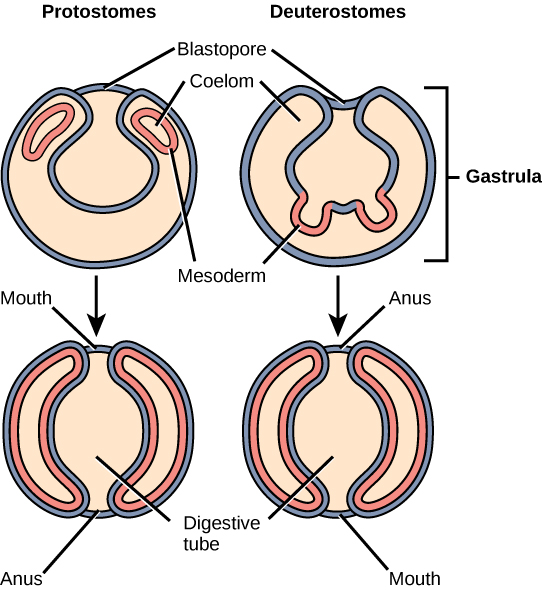
A 2d distinction between the types of cleavage in protostomes and deuterostomes relates to the fate of the resultant blastomeres (cells produced past cleavage). In addition to spiral cleavage, protostomes also undergo determinate cleavage. This means that fifty-fifty at this early stage, the developmental fate of each embryonic prison cell is already determined. A given cell does non accept the ability to develop into any cell type other than its original destination. Removal of a blastomere from an embryo with determinate cleavage can effect in missing structures, and embryos that fail to develop. In contrast, deuterostomes undergo indeterminate cleavage, in which cells are not yet fully committed at this early stage to develop into specific cell types. Removal of private blastomeres from these embryos does not effect in the loss of embryonic structures. In fact, twins (clones) tin be produced as a result from blastomeres that accept been separated from the original mass of blastomere cells. Unlike protostomes, however, if some blastomeres are damaged during embryogenesis, next cells are able to recoup for the missing cells, and the embryo is not damaged. These cells are referred to every bit undetermined cells. This characteristic of deuterostomes is reflected in the existence of familiar embryonic stem cells, which have the ability to develop into any cell type until their fate is programmed at a subsequently developmental phase.
Evolution Connection
The Evolution of the CoelomI of the first steps in the nomenclature of animals is to examine the animal'south body. I structure that is used in classification of animals is the body cavity or coelom. The body cavity develops within the mesoderm, and so merely triploblastic animals tin can take body cavities. Therefore body cavities are found only within the Bilateria. In other animal clades, the gut is either close to the body wall or separated from it by a jelly-like cloth. The torso crenel is important for ii reasons. Fluid within the body cavity protects the organs from daze and compression. In add-on, since in triploblastic embryos, virtually muscle, connective tissue, and claret vessels develop from mesoderm, these tissues developing within the lining of the body crenel can reinforce the gut and body wall, assistance in motility, and efficiently circulate nutrients.
To recap what we take discussed above, animals that do not have a coelom are called acoelomates. The major acoelomate group in the Bilateria is the flatworms, including both free-living and parasitic forms such as tapeworms. In these animals, mesenchyme fills the space betwixt the gut and the body wall. Although two layers of musculus are institute merely under the epidermis, there is no musculus or other mesodermal tissue around the gut. Flatworms rely on passive improvidence for nutrient ship beyond their torso.
In pseudocoelomates, there is a body crenel between the gut and the body wall, simply only the body wall has mesodermal tissue. In these animals, the mesoderm forms, but does not develop cavities within it. Major pseudocoelomate phyla are the rotifers and nematodes. Animals that accept a true coelom are called eucoelomates; all vertebrates, as well equally molluscs, annelids, arthropods, and echinoderms, are eucoelomates. The coelom develops within the mesoderm during embryogenesis. Of the major bilaterian phyla, the molluscs, annelids, and arthropods are schizocoels, in which the mesoderm splits to class the body cavity, while the echinoderms and chordates are enterocoels, in which the mesoderm forms every bit two or more buds off of the gut. These buds separate from the gut and coalesce to form the body crenel. In the vertebrates, mammals have a subdivided torso cavity, with the thoracic cavity separated from the abdominal cavity. The pseudocoelomates may have had eucoelomate ancestors and may have lost their ability to form a complete coelom through genetic mutations. Thus, this step in early embryogenesis—the formation of the coelom—has had a large evolutionary bear on on the various species of the animal kingdom.
Section Summary
Organisms in the fauna kingdom are classified based on their trunk morphology, their developmental pathways, and their genetic affinities. The relationships between the Eumetazoa and more basal clades (Ctenophora, Porifera, and Placozoa) are still beingness debated. The Eumetazoa ("true animals") are divided into those with radial versus bilateral symmetry. More often than not, the simpler and often nonmotile animals display radial symmetry, which allows them to explore their surround in all directions. Animals with radial symmetry are also mostly characterized by the development of two embryological germ layers, the endoderm and ectoderm, whereas animals with bilateral symmetry are by and large characterized by the development of a third embryologic germ layer, the mesoderm. Animals with three germ layers, called triploblasts, are further characterized by the presence or absence of an internal trunk cavity called a coelom. The presence of a coelom affords many advantages, and animals with a coelom may be termed true coelomates or pseudocoelomates, depending the extent to which mesoderm lines the trunk cavity. Coelomates are further divided into one of ii groups called protostomes and deuterostomes, based on a number of developmental characteristics, including differences in zygote cleavage, the method of coelom formation, and the rigidity of the developmental fate of blastomeres.
Visual Connection Questions
(Figure) Which of the following statements is false?
- Eumetazoans have specialized tissues and parazoans don't.
- Lophotrochozoa and Ecdysozoa are both Bilataria.
- Acoela and Cnidaria both possess radial symmetry.
- Arthropods are more closely related to nematodes than they are to annelids.
(Figure) C
(Figure) Which of the following statements about diploblasts and triploblasts is false?
- Animals that display radial symmetry are diploblasts.
- Animals that display bilateral symmetry are triploblasts.
- The endoderm gives rise to the lining of the digestive tract and the respiratory tract.
- The mesoderm gives ascent to the key nervous arrangement.
(Effigy) D
Review Questions
Which of the following organisms is most probable to be a diploblast?
- ocean star
- shrimp
- jellyfish
- insect
C
Which of the post-obit is non possible?
- radially symmetrical diploblast
- diploblastic eucoelomate
- protostomic coelomate
- bilaterally symmetrical deuterostome
B
An fauna whose evolution is marked by radial cleavage and enterocoely is ________.
- a deuterostome
- an annelid or clam
- either an acoelomate or eucoelomate
- none of the above
A
Critical Thinking Questions
Using the following terms, explain what classifications and groups humans fall into, from the near full general to the almost specific: symmetry, germ layers, coelom, cleavage, embryological development.
Humans accept trunk plans that are bilaterally symmetrical and are characterized by the development of three germ layers, making them triploblasts. Humans have true coeloms and are thus eucoelomates. Every bit deuterostomes, humans are characterized by radial and indeterminate cleavage.
Explain some of the advantages brought about through the evolution of bilateral symmetry and coelom formation.
The evolution of bilateral symmetry led to designated head and tail body regions, and promoted more than efficient mobility for animals. This improved mobility immune for more than skilful seeking of resources and casualty escaping from predators. The appearance of the coelom in coelomates provides many internal organs with daze absorption, making them less decumbent to concrete damage from bodily assail. A coelom also gives the body greater flexibility, which promotes more efficient move. The relatively loose placement of organs within the coelom allows them to develop and abound with some spatial liberty, which promoted the evolution of optimal organ system. The coelom also provides space for a circulatory organisation, which is an advantageous way to distribute body fluids and gases.
Glossary
- acoelomate
- creature without a body cavity
- bilateral symmetry
- type of symmetry in which there is only one plane of symmetry, then the left and right halves of an animal are mirror images
- blastopore
- opening into the archenteron that forms during gastrulation
- coelom
- lined body cavity
- determinate cleavage
- cleavage blueprint in which developmental fate of each blastomere is tightly divers
- deuterostome
- blastopore develops into the anus, with the 2nd opening developing into the mouth
- diploblast
- animal that develops from two germ layers
- enterocoely
- mesoderm of deuterostomes develops as pouches that are pinched off from endodermal tissue, cavity contained inside the pouches becomes coelom
- eucoelomate
- brute with a body cavity completely lined with mesodermal tissue
- indeterminate cleavage
- cleavage pattern in which individual blastomeres have the graphic symbol of "stem cells," and are not yet predetermined to develop into specific cell types
- protostome
- blastopore develops into the mouth of protostomes, with the second opening developing into the anus
- pseudocoelomate
- animal with a body cavity located between the mesoderm and endoderm
- radial cleavage
- cleavage axes are parallel or perpendicular to the polar axis, resulting in the alignment of cells between the two poles
- radial symmetry
- blazon of symmetry with multiple planes of symmetry, with torso parts (rays) bundled around a cardinal disk
- schizocoely
- during evolution of protostomes, a solid mass of mesoderm splits apart and forms the hollow opening of the coelom
- spiral cleavage
- cells of 1 pole of the embryo are rotated or misaligned with respect to the cells of the reverse pole
- triploblast
- fauna that develops from three germ layers
Source: https://opentextbc.ca/biology2eopenstax/chapter/features-used-to-classify-animals/
Posted by: hambybuir1998.blogspot.com

0 Response to "Which Characteristic Is Not One Of The Main Features Used To Classify Animals?"
Post a Comment